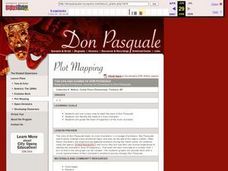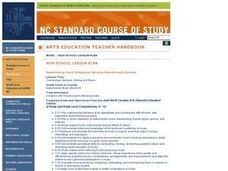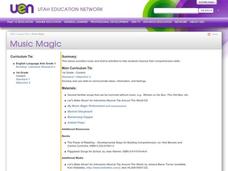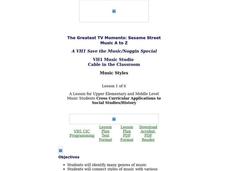Curated OER
Clowning Around: Drawing
Kids create a clown out of shapes. They work to show emotions while practicing their drawing skills. Pupils use circles, triangles, squares, oil pastels, and their imagination to draw, color, and decorate a sad or happy clown. Tip: Have...
Curated OER
Slices of American Pie: The 1960s Through Music
Eleventh graders examine political, cultural, and social movements through music. For this 1960s American history lesson, 11th graders explore the music of the decade in order to better understand the complexity of the time period....
Curated OER
The Ups and Downs of don Pasquale: Mapping the Emotional Journey of Characters in Don Pasquale
Students listen to and retell the story of Don Pasquale. They evaluate the emotions of the main characters. Students create a graph of the emotions of Don Pasquale.
Curated OER
Music of the Civil War
Students gain insight into the Civil War era by exploring the art, music, and literature of the time.
California Department of Education
Creating a Therapeutic Soundscape: Ambient Improvisations and Planned Catharsis (CTE)
How is music a form of therapy? Scholars explore the topic using the fourth and final instructional activity from the Changing One's Tune: A Music Therapy STEM series. Learners explore the relationship between music and the mind and...
Curated OER
Cover the Music
Students explore U.S. history by listening to musical pieces in class. In this Civil War era lesson, students discuss the types of musical instruments that were available to soldiers during the war and the themes of their songs. Students...
Curated OER
Wynton's Tune
Learners examine the serigraph, "Wynton's Tune," by artist Faith Ringgold. They discuss the painting, listen to jazz music, create a drawing that tells a story inspired by their favorite music, and write sentences describing their artwork.
Curated OER
Butterflies Fly!
Chopin was a lovely composer who played the piano masterfully. Third graders are introduced to Chopin, his piano sounds, triple meter, music patterns, movement, and the waltz. They listen to his music while hearing the story Butterflies...
Curated OER
Connecting Literature, Writing and Music
Learners assess the impact of music to portray emotions and tell stories. Examples are taken from the life of Rosa Parks and a piece of band music called "A Movement for Rosa". Evaluation is accomplished through in-class participation...
Curated OER
Aesthetics and Affect in Music from Around the World
Students explore traditional music of different societies around the world by listening to number of different musical recordings, discuss how music makes them feel, examine how music is central to cultural traditions, and compose short...
Hold McDougal
Songwriting Skill - Finding Your Style: Elisa Victoria - “No Surprise”
Hip Hop? Country? Punk? R and B? So many styles. Young song writers consider the emotional effects of various style options before selecting the style best suited to the emotions they want to express in their song. The sixth in a...
California Department of Education
Hitting the Write Note: Writing a Proposal
To whom it may concern ... Scholars undergo the process of writing a letter to an authority figure. The activity asks writers to compose a formal letter requesting a music therapy space. Pupils learn how to submit a project proposal to...
Curated OER
Hispanic Arts: Visual Arts, Dance and Music
Students observe global cultures by listening to music and watching videos. In this Latin American dance instructional activity, students define merengue, salsa and other dances from the Hispanic culture while listening to Latin rhythm...
Curated OER
World Music Day
In this World Music Day worksheet, students complete activities such as reading a passage, phrase matching, fill in the blanks, correct words, multiple choice, spelling, sequencing, scrambled sentences, writing questions, survey, and...
Curated OER
Music- Found-Object Orchestra
Learners construct simple musical instruments. In this music instructional activity, students read the text Max Found Two Sticks and construct their own instruments from classroom materials.
Curated OER
Arts have Emotional Impact
Students explore how various artists use color, line and composition to create a mood. In comparison, students explore various elements of specific art forms that affect the viewer's emotions in dance, theater music and the visual...
Curated OER
How and Why to Look at Abstract Painting - Activity 1
Students create abstract art using acrylic paints and canvas in this lesson provided by Oregon Public Broadcasting. The lesson includes information on abstract art and video links.
Bierbaum Elementary School
Practicing Patience
As teachers, we have a lot of patience. Our scholars, on the other hand, may need some support. Give your pupils the emotional intelligence instruction they desire with a lesson designed to teach patience through grand conversation,...
Curated OER
Music Styles
Students identify many genres of music and connect styles of music with various cultures. They watch "The Greatest TV Moments: Sesame Street Music A to Z" and list music styles: folk, jazz, rock, etc.
Curated OER
The Influence of Jazz Music in Twentieth Century Art
Students examine the effect of music on society. While listening to music, they identify the beat, rhythm and write down their reaction to it. Listening to longer selections, they assign a color to the music and share it with the...
Curated OER
Introduction to the Romantic Age of English Literature
Introduce your class to the elements of Romanticism with these slides. The foundations of the movement, the roles of imagination and nature, and the value of art are all highlighted. Features of Romanticism are explained such as...
Curated OER
Hot, Hot, Hot, Cold
Learners dance the image of falling snow. They move, swing, fall, and rise to music working to depict snow falling, the sun, and high/low movements. This is a well-thought out lesson that aids them in seeing movement as a form of...
Teachers Pay Teachers
What Kind of Smart Are You
Gain insight into the type of learners that fill your classroom. An eight-question survey asks scholars questions about themselves. Using their color-coded answers, they conclude their degree of intelligence in multiple areas—music,...

























